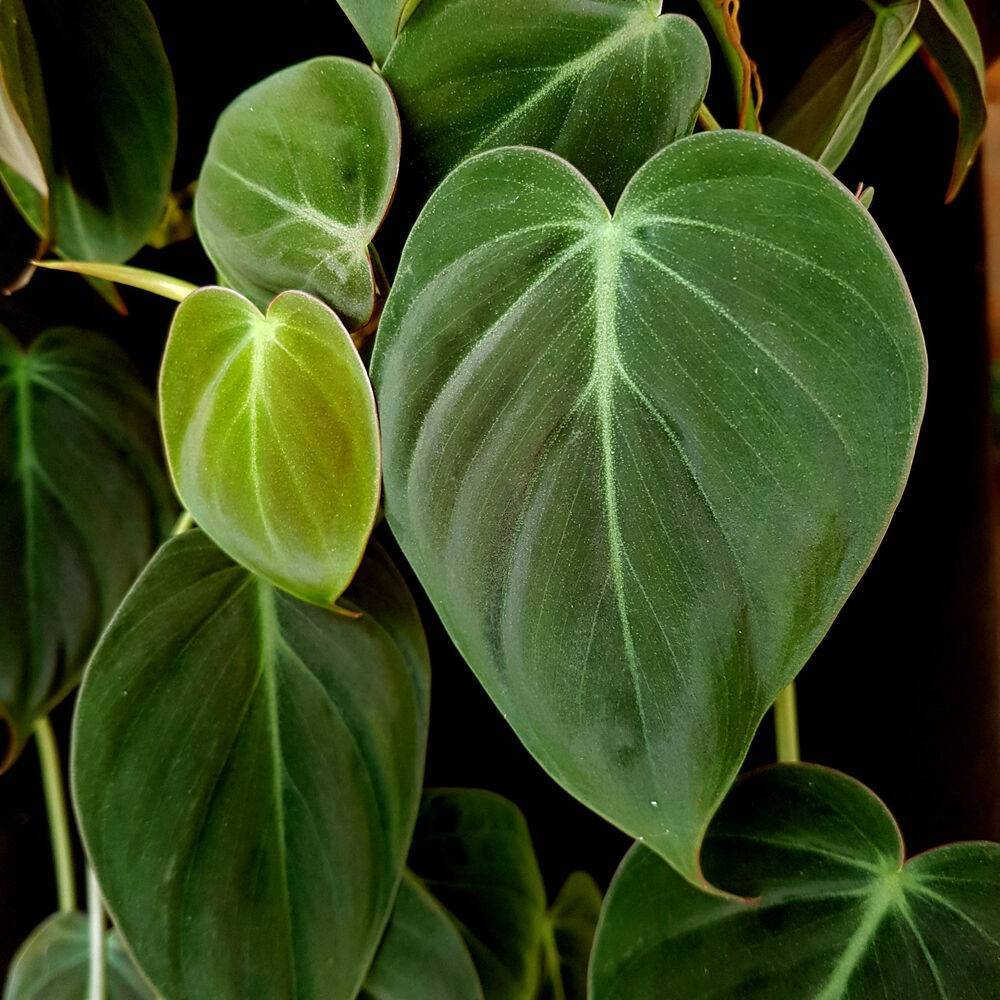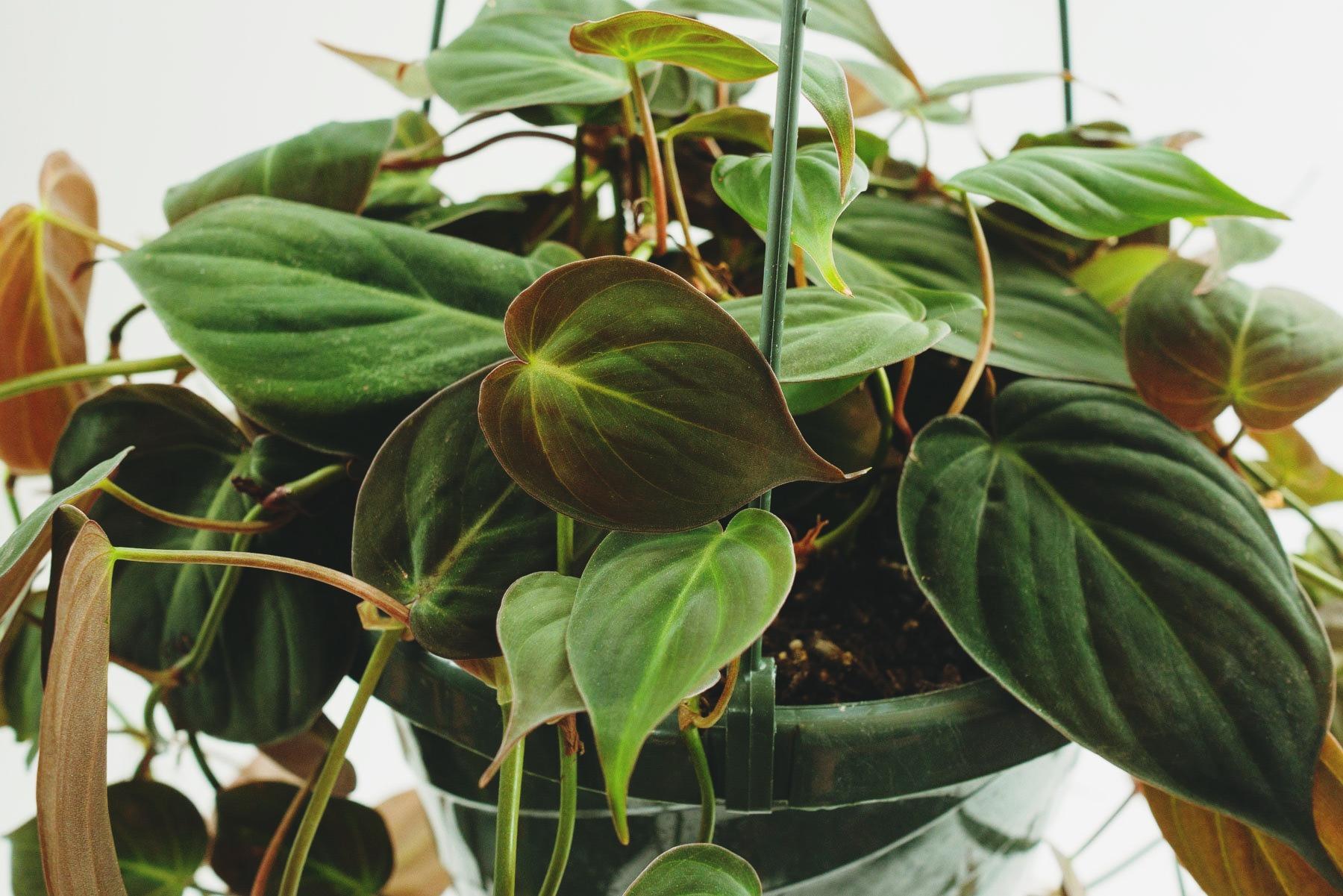Philodendron Micans Overview
Welcome to the guide on caring for the Philodendron Micans, a plant that has quickly become a favorite among houseplant enthusiasts. Known for its stunning velvet-like leaves and a captivating hue that dances between shades of green and purple, the Philodendron Micans, or the Velvet Leaf Philodendron, is a must-have for any indoor garden.
Originating from the Caribbean and Central America, the Philodendron Micans is part of the larger Philodendron genus, a group known for its air-purifying qualities and easy-to-care-for nature. This particular species stands out for its unique foliage – heart-shaped leaves with a velvety texture and iridescent tones. It’s a climbing variety, often using aerial roots to adhere to surfaces, making it an ideal choice for hanging baskets or allowing it to trail elegantly from shelves.
Whether you are a seasoned gardener or just beginning your journey with houseplants, the Philodendron Micans offers a rewarding experience with its easy-to-grow nature and visually stunning appearance.

| Feature | Details |
|---|---|
| Common Name | Velvet Leaf Philodendron |
| Botanical Name | Philodendron hederaceum var. hederaceum |
| Family | Araceae |
| Plant Type | Vine, Houseplant |
| Mature Size | Up to 8 feet (indoors) |
| Sun Exposure | Medium to Low, Indirect Light |
| Bloom Time | Rarely blooms indoors |
| Toxic | Yes, toxic if ingested |
| Hardiness Zones | Generally not hardy (indoor plant) |
| Native Area | Caribbean, Mexico, Central to South America |
Philodendron Micans Plant Care Guide
This guide provides in-depth care tips to help your Philodendron Micans thrive indoors.
Light
Philodendron Micans is a versatile plant when it comes to lighting requirements. It prefers bright, indirect light but can also adapt to medium light conditions. The key is to avoid direct sunlight, which can scorch its delicate leaves, robbing them of their stunning iridescence. A spot near an east or north-facing window is ideal, offering the plant enough light without the harsh intensity of direct sun.
If you notice the leaves losing their characteristic shimmer or the stems becoming leggy, it’s a sign that your Philodendron Micans may not be receiving enough light. Conversely, leaves turning yellow might indicate too much direct sunlight.
Water
Watering is crucial in the care of Philodendron Micans. This plant prefers its soil to be consistently moist, but not waterlogged. Overwatering can lead to root rot, a common issue with Philodendrons. The best approach is to check the top inch of the soil; if it feels dry, it’s time to water.
During the growing season (spring and summer), your Philodendron Micans will require more frequent watering. In winter, reduce the frequency as the plant’s growth slows down. Using lukewarm water is a good practice, as cold water can shock the roots.
Soil
Philodendron Micans thrives in well-aerated, well-drained soil that can retain moisture without becoming soggy. A peat moss-based potting soil mixed with perlite or orchid bark is an excellent choice. This mix ensures good drainage and aeration, providing the roots with the ideal balance of moisture and oxygen.
Be mindful of the soil’s tendency to compact over time, which can impede drainage. Repotting every couple of years with fresh soil can keep your Philodendron Micans healthy and encourage growth.
Temperature and Humidity
Philodendron Micans, a tropical plant, prefers a warm and humid environment. Aim to maintain a temperature range between 65°F to 80°F (18°C to 27°C). Avoid placing your plant near drafts or heating/cooling vents, as fluctuations in temperature can stress the plant.
Humidity plays a significant role in keeping your Philodendron Micans happy. Strive for a humidity level of 60% or higher. In dry climates or during winter months, using a humidifier can help achieve this. Alternatively, placing a water-filled pebble tray beneath the plant’s pot can increase the surrounding humidity.
Fertilizer
Fertilizing your Philodendron Micans supports its growth and maintains the health of its vibrant leaves. Use a balanced, water-soluble fertilizer, diluted to half the recommended strength. Fertilize once a month during the growing season and reduce to every six to eight weeks in fall and winter.
Avoid over-fertilizing, as this can lead to salt buildup in the soil, potentially harming the plant. If you notice the leaves turning brown at the tips, it could be a sign of fertilizer burn, indicating the need to cut back on feeding.
By following these care tips, your Philodendron Micans will continue to be a stunning addition to your indoor garden. Remember, consistency in care is the key to keeping your Velvet Leaf Philodendron healthy and thriving.

Velvet Leaf Philodendron Growing Guide
How to Propagate
Philodendron Micans, known for its easy-care nature, can be easily propagated to increase your collection or share with friends.
- Stem Cuttings: This is the most common method of propagating Philodendron Micans.
- Choose a healthy stem with several leaves and at least one node (where the leaf attaches).
- Cut just below the node using clean, sharp scissors.
- You can propagate the cuttings either in water or directly in soil.
- Water Propagation: Put the stem cuttings in a jar of water, making sure at least one node is submerged. Change the water regularly until roots develop, then transfer to soil.
- Soil Propagation: Plant the cuttings in a potting mix rich in organic matter and peat moss. Keep the soil moist until new growth appears.
Propagation is best done in the spring or early summer when the plant is in its active growing phase.
Potting and Repotting
Philodendron Micans thrives in a well-draining soil mixture that’s high in organic matter. The potting mix should allow for adequate drainage while retaining enough moisture to keep the soil moist.
- Potting: Choose a pot with drainage holes to prevent water from sitting at the bottom. A mix of peat moss, perlite, and regular potting soil works well for Philodendron Micans.
- Repotting: This plant likes to be slightly root-bound, so repotting every 2-3 years is sufficient. Choose a pot that’s slightly larger than the current one. When repotting, be gentle with the roots and use fresh soil.
Pruning
Pruning helps maintain the shape of your Philodendron Micans and encourages new growth.
- When to Prune: Prune in the spring or early summer, when the plant is growing more actively.
- How to Prune: Using clean, sharp scissors, cut back any overly long vines or any leaves that are yellow or damaged. This not only keeps your plant looking tidy but also helps the plant focus its energy on new growth.
- Additional Benefits: Pruning can stimulate the plant to produce new leaves, keeping your Philodendron Micans lush and full.
Philodendron Micans is a robust plant that adapts well to various light conditions, from medium indirect light to lower light environments. However, too much light can scorch the leaves, while too little light can lead to smaller leaves and leggy growth. Finding the right balance of light is crucial.
For watering, let the top inch of soil dry out between waterings. Overwatering can lead to root rot, so it’s essential to check the soil moisture before adding more water. Misting your plant can also help increase the humidity around the plant, mimicking its natural tropical habitat.
Pests and Diseases
Philodendron Micans, is relatively easy to care for. However, like all plants, it can encounter its share of pests and diseases. Understanding these challenges and knowing how to tackle them effectively is key to maintaining the health and beauty of your plant.
Pests
1. Identifying Common Pests
Philodendron Micans, due to its lush foliage, can sometimes attract a range of pests. The most common include:
- Spider Mites: Tiny arachnids that can cause the leaves to appear speckled or bronzed.
- Mealybugs: These appear as small, cottony masses in the leaf axils or under leaves.
- Aphids: Often found on new growth, they suck the sap from the plant.
2. Effective Pest Control Strategies
The key to managing pests is early detection and prompt action.
- Regular Inspections: Regularly check the leaves, especially the undersides and new growth, for signs of pests.
- Washing: Sometimes, a strong jet of water can dislodge pests like aphids.
- Insecticidal Soap or Neem Oil: These can be effective against a range of pests. Apply as per instructions, ensuring to cover all parts of the plant.
- Isolation: If you find pests, isolate the affected plant to prevent them from spreading to other houseplants.
Plant Diseases
1. Common Diseases in Philodendron Micans
Philodendron Micans is relatively resistant to diseases, but it can still be affected, especially when the care needs are not met properly.
- Root Rot: Overwatering can lead to soggy soil, causing root rot. The first sign is often yellowing leaves.
- Leaf Spot Disease: Caused by either fungal or bacterial pathogens, it appears as dark spots on the leaves.
2. Disease Prevention and Treatment
Prevention is better than cure when it comes to plant diseases.
- Proper Watering Schedule: Allow the soil to dry out between waterings. This is crucial to prevent root rot.
- Good Air Circulation: Ensure your Philodendron Micans is in a well-ventilated area to reduce the risk of fungal diseases.
- Cleanliness: Keeping the leaves clean can help prevent leaf spot diseases. Wipe the leaves with a damp cloth occasionally.
- Repotting: If root rot is suspected, repot the plant into fresh soil and inspect the roots, trimming away any that are blackened or mushy.
General Care Tips for a Healthy Philodendron Micans
- Light: Philodendron Micans thrives in medium to bright indirect light. Avoid direct sunlight which can scorch the leaves.
- Soil: Use a well-aerated, fast-draining soil mix. Adding worm castings can provide extra nutrition.
- Humidity: As a tropical plant, it appreciates higher humidity levels. Misting can help increase humidity around the plant.
- Fertilization: During the growing season, fertilize monthly with a balanced fertilizer to encourage robust growth.
Megan Stewart, a houseplant aficionado and biologist, resides in the city of Portland, Oregon, USA. Her passion for greenery is matched only by her academic prowess; Megan holds a degree in Biology from the University of Oregon. This background has provided her with a rich understanding of the biological intricacies of plant life, which she skillfully applies to her collection of indoor plants.
Megan's home is a testament to her love for all things green, filled with a diverse array of houseplants ranging from exotic orchids to robust succulents. When she's not tending to her indoor garden, she spends her time with her beloved pets, a constant source of companionship and joy. Her articles are a reflection of her life's passions, offering readers a blend of practical plant care advice, and insightful biological tidbits.
Through her writing, Megan aims to inspire others in the USA and beyond to create their urban jungles and foster a deeper connection with nature.


